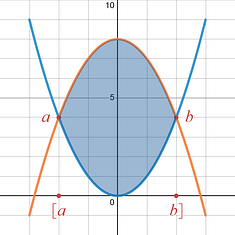Method: Cross Sectional Areas
The most important part of this method is the creation of your area equation, A(x) .
Keep in mind that the equations you are given to work with are not the area equation themselves. The equations you are given in the problem will only represent some edge of your shape. The area you are looking for might be a circle, and the equations you are given might represent the diameter of that circle. You will need to use your geometry and trig skills to help you create your actual area equation.
Step 1: Identify the shape whose area equation, A(x) , you need find, and write down that general area formula.
They will usually use a statement like:
– “Cross-sections are squares with…” You know that you are going to need the area formula for a square.
– “The cross-sections are circular disks with…” You know that you are going to need the area formula for a circle.
At this point in the process do not try to write the final area equation, A(x) , you will need to use, just write down the general area formula as you have it memorized.
As you can imagine they can choose from many different geometric shapes, and you will need to know those general area formula off the top of your head.
– General area formulas I would recommend knowing:
- Area of a Circle:
- Area of a Half-Circle:
- Area of a Triangle:
- Area of a Rectangle:
- Area of a Square:
– Geometry concepts to keep in mind:
- All sides of an equilateral triangle are equal.
- The diagonal of a square creates a 45-45-90 triangle with the edges.
– Trigonometry concepts to keep in mind:
- Know your 30-60-90 triangle sides.
- Know your 45-45-90 triangle sides.
- Know sine, cosine, and tangent in terms of opposite, adjacent, and hypotenuse.
Step 2: Use your given equations to create an equation for the edge (base, height) or dimension (diagonal, diameter) of the geometric shape you are working with.
You might find it helpful to draw a picture of your given equations and label the side by its given name (i.e., diameter, radius, side).
Again, keep in mind that the edge equation you create here is not the actual area equation, A(x) . It is a formula that describes some part of the general area formula you wrote down in Step 1 .
There are basically two methods to use to determine the equation for your edge.
– Option 1: The edge is created by drawing a line between your given equation and the x-axis . The given function’s y-value provides the length of your edge.
– Option 2: The edge is created by drawing a line between your two given equations. Use the Area Between 2 Curves, Top–Bottom method, to determine the length of your edge.
Step 3: Take your general area formula from Step 1 , and determine equations for each variable of the formula based on the edge equation you found in Step 2 .
If you were looking to find the area of a circle , you would first write down the general area formula, . That would let you know that you must find a formula for the radius = r in order to create your actual area equation, A(x) .
– Ask yourself, “How does your edge equation from Step 2 relate to what you need to plug into your actual area equation, A(x) ? ”
- Is your edge a diameter of a circle and you need the radius because you are doing the area of a circle ? Well then multiply your edge equation by and you have the radius equation you needed for the area equation, A(x) .
- Is your edge one side of an equilateral triangle and you need the base and height because you are doing the area of a triangle ? All your pieces can be found using that side and a 30-60-90 triangle.
- Try not to let the fact that you are working with equations for the edges instead of hard and fast numbers throw you. Keep in mind what that the edge equation represents ( radius , diameter , base , height ) and try to figure out how that edge fits your general area formula.
- What you have might be all that you need (it is the radius and all you need is the radius ), but it could take a little more thought to get there (it is the diameter and you need the radius ).
Step 4: Create your actual area equation, A(x) , using the pieces you found in Step 3 .
The actual area equation, A(x) , is the equation for one slice out of the full loaf of bread .
Step 5: Determine the bounds of the integral, .
Your bounds are either going to be the intersection of your two equations, they will be defined by an equation you were given, or they will be given in the language of the problem.
|
Intersections as Bounds
|
Equations as Bounds
|
Step 6: Setup and evaluate the definite integral you created, , to find your final Volume.
Use the definite integral to add up, accumulate, all the slices of bread and find the volume of your loaf of bread .



